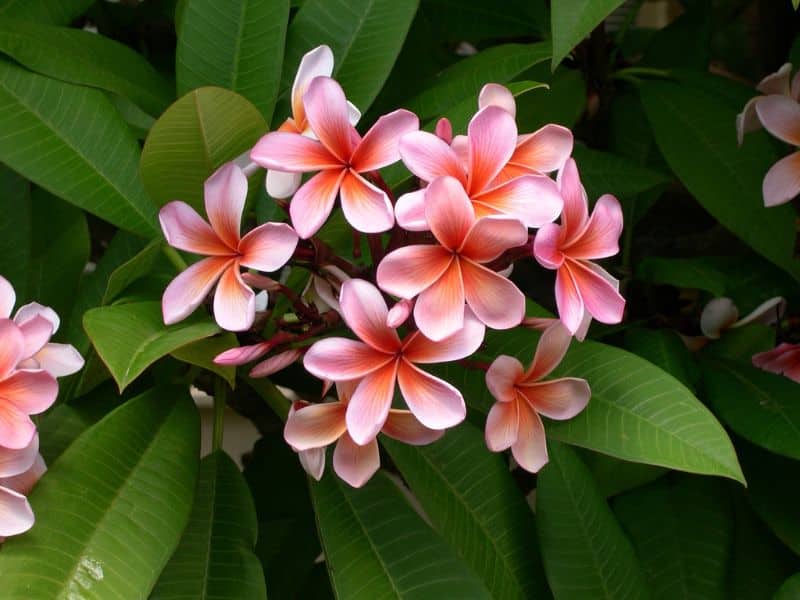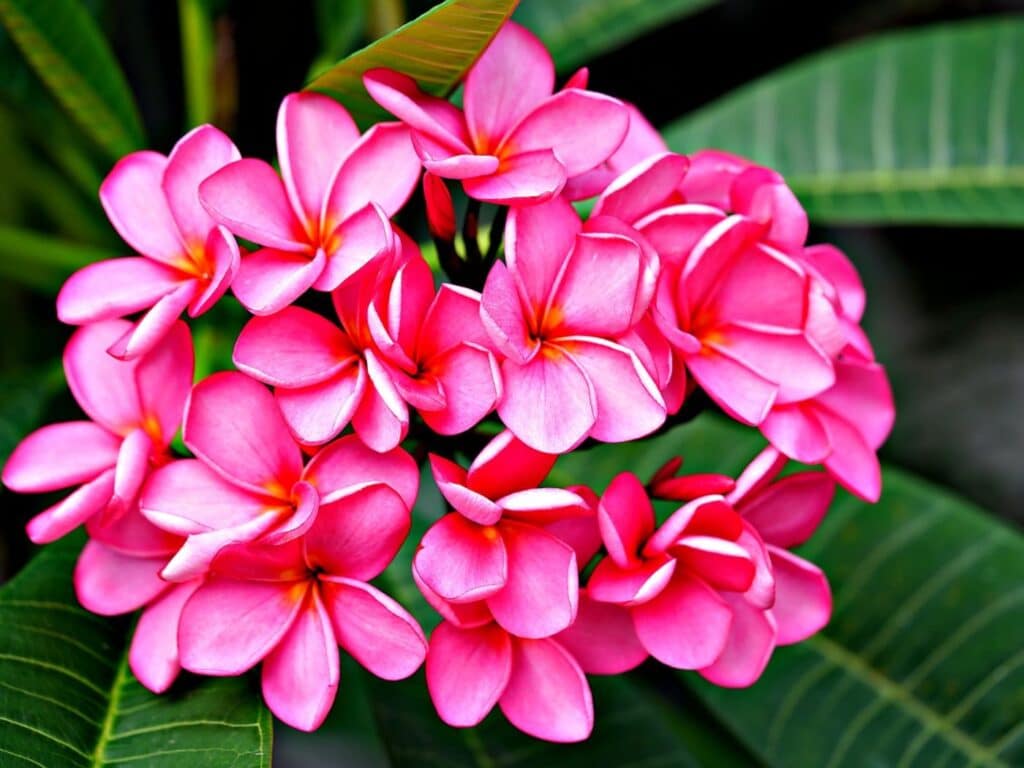Imagine stepping into a garden where the air is fragrant with the sweet aroma of plumeria, each bloom competing in beauty and uniqueness. Plumerias, with their stunning palette of colors and captivating scents, have charmed gardeners and flower enthusiasts around the globe.
But did you know that the world of plumeria is as diverse as it is beautiful? From the vibrant hues of the ‘Rainbow’ to the delicate whispers of the ‘Celadine’, each variety has its own story to tell.
Choosing the right plumeria variety can transform your garden into a tropical paradise, but with so many options, it can be overwhelming. Whether you’re a seasoned gardener or a budding enthusiast, understanding the nuances of these varieties can make all the difference.
Let’s embark on a journey to uncover the secrets of plumeria varieties, guiding you to select the perfect match for your garden oasis.
Understanding Plumeria

The Origins of Plumeria
Plumeria, also fondly known as frangipani, traces its roots back to the warm climates of Central America, Mexico, and the Caribbean. Imagine these exotic locales, where the air is thick with enchanting fragrances and the landscapes are painted with the lush, vibrant hues of these flowers.
Over centuries, plumeria has journeyed across the world, taking up residence in almost every tropical and subtropical garden you can think of. This migration has led to a rich diversity of species and hybrids, each carrying a piece of history from its native land.
Common Features Across Varieties
Despite the vast array of colors and scents plumeria offers, all share some common traits that gardeners love. First off, let’s talk blooms: these are the show-stoppers, ranging from white to deep red, often adorned with contrasting centers that catch the eye.
Next up, the leaves. Glossy and green, they’re the perfect backdrop to those dazzling flowers. And let’s not forget the scent – from subtle notes to heady fragrances, plumeria flowers seem to have mastered the art of perfumery. No matter which variety makes its way into your garden, these are the delightful constants you’ll get to enjoy.
Exploring the Diversity of Plumeria Varieties
The Brushstrokes of Color: Flower Types
Diving into the colorful world of plumeria, you’ll find an astonishing array of flower types. From the radiant whites and yellows reminiscent of sunrise to the deep reds and pinks that echo the hues of a tropical sunset, each variety brings its own charm.
Some plumerias flaunt a single shade, while others surprise with petals blending multiple colors, creating a visual feast. This kaleidoscope of options ensures you’ll find the perfect match for the visual theme of your garden.
A Spectrum of Scents
The fragrance of plumeria flowers is as diverse as their colors. Imagine walking through your garden and being greeted by aromas ranging from sweet citrus to spicy cinnamon, with some varieties offering a delicate jasmine scent.
This spectrum of fragrances has the power to transform your outdoor space into an aromatic paradise where every breath is a journey to a different corner of the tropics. By selecting plumerias based on scent, you can curate an olfactory experience that’s both enchanting and personalized.
Leaf Patterns and Tree Shapes
Beyond flowers, plumerias captivate with their leaf patterns and tree shapes. Leaves may vary from slender to broad, with some showcasing a glossy sheen that dazzles under the sun.
Tree forms also differ, from the statuesque stand-alone types, ideal for a garden centerpiece, to the more sprawling varieties that crave companionship along garden paths or as background foliage. This diversity allows gardeners to play architect, designing spaces that draw the eye upwards or create cozy, inviting nooks.
Navigating through the diversity of plumeria varieties isn’t just about picking a pretty flower or a pleasant scent. It’s about composing a landscape that ignites the senses, offers moments of peace, and reflects your personal style.
Whether you aim for a garden that’s a riot of color or an oasis of calm, the world of plumeria has everything you need to make it happen.
Top Picks: Popular Plumeria Varieties

Dwarf and Compact Types
Selecting a dwarf or compact plumeria allows you to enjoy the stunning beauty and aroma of these flowers even in smaller spaces. Plumerias like ‘Petite Pink’ and ‘Mini White’ thrive in pots, making them perfect for balconies or patios. They bloom generously with vibrant flowers, offering a colorful addition to your outdoor area without requiring a large garden space.
Giant and Showstopping Varieties
For those who love a dramatic garden scene, giant plumeria varieties, such as ‘California Sally’ and ‘Lei Rainbow’, make an unforgettable impact.
These larger-than-life flowers come in a dazzling array of colors and can tower over the landscape, creating a focal point that’s both visually striking and fragrantly rich. Imagine a tree full of large, colorful blooms that can be seen (and smelled) from across the yard.
Rare and Exotic Choices
If you’re after something truly eye-catching, rare and exotic plumerias like ‘Celadine’ and ‘Puu Kahea’ offer distinctive beauty. With unusual colors, patterns, and fragrances, these varieties stand out from the more common types.
For the enthusiast looking to add a conversation piece to their garden, diving into the world of rare plumerias may well just be the perfect adventure. These exceptional choices often come with the thrill of discovery and the pride of growing something truly special.
Caring for Your Plumeria
Best Practices for Cultivation
Selecting the right spot is one of the most important parts of caring for your plumeria. These plants love full sun and well-draining soil. So, if you’re eyeing that sunny spot in your garden, go for it. Plumeria’s need for sunlight cannot be overstated; they thrive with at least six hours of direct sunlight per day.
On the watering front, consistency is key. Allow the plumeria soil to dry out slightly between watering sessions. Overwatering can spell disaster, leading to root rot. During the growing season, a balanced fertilizer will do wonders for your plumeria, promoting lush, vibrant blooms.
Remember, a happy plumeria is a well-fed and sun-bathed one.
Creating a Plumeria Paradise
Landscaping With Diverse Varieties
In your quest to create a plumeria paradise, diversity is your best friend. Choose from a broad selection of plumerias, ranging from the compact ‘Petite Pink’ to the majestic ‘California Sally’, to fit every corner of your garden.
By incorporating varieties that bloom at different times, you ensure a continuous display of colors and scents. Think of your garden as a canvas, with plumerias adding splashes of color throughout the seasons.
Combining Colors and Scents
Achieving harmony in your garden involves more than just placing plants haphazardly. Consider combining plumeria colors and scents that complement each other, like pairing the citrusy aroma of ‘Thai Yellow’ with the deep red hues of ‘Black Widow’.
This approach creates layers of sensory experiences for anyone wandering through your garden. Remember, the goal is a feast for the eyes and the nose, with each step unveiling new delights.
Frequently Asked Questions
What are plumeria flowers?
Plumeria flowers are tropical plants known for their vibrant colors and captivating scents. They are a popular choice for gardens due to their beauty and variety.
Where do plumeria flowers originate from?
Plumerias originate from tropical regions of the Americas. They have since spread around the world, becoming a staple in many tropical and subtropical landscapes.
What are some popular plumeria varieties?
Two popular varieties include ‘Petite Pink’ and ‘California Sally’. These cater to different garden sizes while ensuring a diversity of colors and fragrances.
How should plumeria flowers be cared for?
Proper care includes planting them in sunny locations with well-draining soil, regular watering without over-saturation, and providing balanced fertilization to support their growth and blooming.
How can one create a sensory-rich landscape with plumerias?
To create a sensory-rich landscape, combine diverse plumeria varieties with varying colors and scents. This approach ensures continuous blooms and a harmonious blend of fragrances, enhancing the garden’s sensory appeal.
Why is diversity important in planting plumerias?
Diversity in plumeria planting ensures a range of colors, sizes, and scents, contributing to a visually and aromatically pleasing environment. It allows for continuous blooming and variation throughout the seasons.
Discover the meaning behind the bloom of the plumeria to understand why so many people like this plant.







